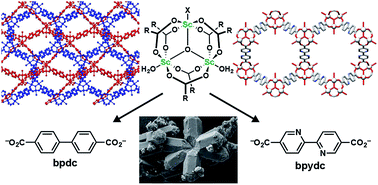当前位置:
X-MOL 学术
›
J. Mater. Chem. A
›
论文详情
Our official English website, www.x-mol.net, welcomes your
feedback! (Note: you will need to create a separate account there.)
Controlling interpenetration through linker conformation in the modulated synthesis of Sc metal–organic frameworks†
Journal of Materials Chemistry A ( IF 10.7 ) Pub Date : 2017-12-15 00:00:00 , DOI: 10.1039/c7ta09699b Ross J. Marshall 1, 2, 3, 4, 5 , Ciaran T. Lennon 1, 2, 3, 4, 5 , Andi Tao 6, 7, 8, 9, 10 , Hans M. Senn 1, 2, 3, 4, 5 , Claire Wilson 1, 2, 3, 4, 5 , David Fairen-Jimenez 6, 7, 8, 9, 10 , Ross S. Forgan 1, 2, 3, 4, 5
Journal of Materials Chemistry A ( IF 10.7 ) Pub Date : 2017-12-15 00:00:00 , DOI: 10.1039/c7ta09699b Ross J. Marshall 1, 2, 3, 4, 5 , Ciaran T. Lennon 1, 2, 3, 4, 5 , Andi Tao 6, 7, 8, 9, 10 , Hans M. Senn 1, 2, 3, 4, 5 , Claire Wilson 1, 2, 3, 4, 5 , David Fairen-Jimenez 6, 7, 8, 9, 10 , Ross S. Forgan 1, 2, 3, 4, 5
Affiliation

|
Interpenetration in metal–organic frameworks (MOFs), where multiple nets of metal ions or clusters linked by organic ligands are nested within each other's pore spaces, affects important physical properties such as stability and gas uptake, and can be controlled through ligand sterics and modifying synthetic conditions. Herein, we extend the use of coordination modulation – deliberate addition of competing monotopic ligands to syntheses – to prepare Sc MOFs containing related biphenyl-4,4′-dicarboxylate (bpdc) and 2,2′-bipyridine-5,5′-dicarboxylate (bpydc) linkers. The Sc-bpdc MOF adopts a two-fold interpenetrated structure, however, the Sc-bpydc MOF is non-interpenetrated, despite only minor electronic modifications to the ligand. A comprehensive experimental and theoretical examination reveals that ligand twisting (energetically favourable for bpdc but not bpydc) and associated π-stacking interactions are a prerequisite for interpenetration. The more rigid Sc-bpdc is susceptible to modulation, resulting in differences in morphology, thermal stability and the synthesis of a highly defective, acetate-capped mesoporous material, while the large pore volume of Sc-bpydc allows postsynthetic metallation with CuCl2 in a single-crystal to single-crystal manner. Controlling interpenetration through linker conformation could result in design of new materials with desirable properties such as bifunctional solid-state catalysts.
中文翻译:

通过Sc金属-有机骨架的调制合成中的接头构象控制互穿†
在金属-有机骨架(MOF)中的互穿,其中由有机配体连接的多个金属离子或簇网相互嵌套在彼此的孔空间内,影响重要的物理性质,例如稳定性和气体吸收,并且可以通过配体的位阻和修饰来控制合成条件。在本文中,我们扩展了配位调制的使用-故意添加竞争性单分子配体以进行合成-制备含有相关联的联苯基4,4'-二羧酸(bpdc)和2,2'-联吡啶-5,5'-二羧酸的Sc MOF (bpydc)连结器。Sc-bpdc MOF采用双重互穿结构,但Sc-bpydc MOF是非互穿的,尽管仅对配体进行了少量电子修饰。全面的实验和理论研究表明,配体扭曲(对bpdc有利,但对bpydc不利)和相关的π堆积相互作用是互穿的先决条件。刚性更高的Sc-bpdc易受调节,导致形态,热稳定性的差异以及高度缺陷的醋酸盐封端介孔材料的合成,而Sc-bpydc的大孔体积允许与CuCl进行合成后的金属化图2以单晶至单晶的方式。通过接头构象控制互穿可导致设计具有期望特性的新材料,例如双功能固态催化剂。
更新日期:2017-12-15
中文翻译:

通过Sc金属-有机骨架的调制合成中的接头构象控制互穿†
在金属-有机骨架(MOF)中的互穿,其中由有机配体连接的多个金属离子或簇网相互嵌套在彼此的孔空间内,影响重要的物理性质,例如稳定性和气体吸收,并且可以通过配体的位阻和修饰来控制合成条件。在本文中,我们扩展了配位调制的使用-故意添加竞争性单分子配体以进行合成-制备含有相关联的联苯基4,4'-二羧酸(bpdc)和2,2'-联吡啶-5,5'-二羧酸的Sc MOF (bpydc)连结器。Sc-bpdc MOF采用双重互穿结构,但Sc-bpydc MOF是非互穿的,尽管仅对配体进行了少量电子修饰。全面的实验和理论研究表明,配体扭曲(对bpdc有利,但对bpydc不利)和相关的π堆积相互作用是互穿的先决条件。刚性更高的Sc-bpdc易受调节,导致形态,热稳定性的差异以及高度缺陷的醋酸盐封端介孔材料的合成,而Sc-bpydc的大孔体积允许与CuCl进行合成后的金属化图2以单晶至单晶的方式。通过接头构象控制互穿可导致设计具有期望特性的新材料,例如双功能固态催化剂。









































 京公网安备 11010802027423号
京公网安备 11010802027423号